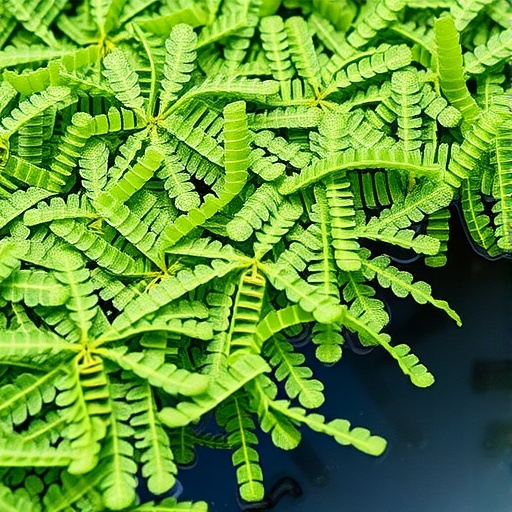In recent years, the pursuit of sustainable energy and waste management solutions has taken center stage in the face of climate change and environmental degradation. One innovative approach, integrating advanced biophotovoltaic systems using microalgae, has emerged as a promising avenue for harnessing renewable energy while simultaneously addressing waste treatment challenges. This fascinating approach utilizes palm oil mill effluent (POME) as a substrate for microalgae cultivation, thus aiming to generate electricity, purify biogas, and valorize bioproducts.
The significance of using palm oil mill effluent as a medium for microalgae-based systems cannot be understated. POME is a byproduct of palm oil production, and its disposal can pose severe environmental hazards due to its high organic content and the potential for contaminating water resources if not managed properly. By repurposing this waste material, the integrated biophotovoltaic systems not only offer a method for treating effluent but also pave the way for generating clean energy. This dual-functionality perfectly aligns with the principles of circular economy, wherein waste is transformed into valuable resources.
When it comes to bioenergy production, microalgae possess several advantages over traditional crops. They have rapid growth rates, require less land area, and can be cultivated in various environments, including wastewater. Microalgae also demonstrate impressive abilities to capture carbon dioxide while assimilating nutrients, making them essential players in mitigating greenhouse gas emissions. This remarkable capacity is enhanced when they are cultivated in a carefully designed biophotovoltaic setup, which effectively converts light energy into electricity through photosynthetic reactions.
The interplay between microalgae and bioelectrochemical systems is foundational for the functioning of biophotovoltaic systems. During photosynthesis, microalgae absorb light and convert it into chemical energy. This energy is subsequently integrated into an electrode, producing electric currents. This phenomenon not only serves as a clean energy source but also promotes the degradation of organic matter present in the effluent, thus enabling simultaneous wastewater treatment. Furthermore, this process can generate biogas, predominantly comprising methane, which can be used as a renewable energy source.
To assess the feasibility and efficiency of integrated microalgae-based biophotovoltaic systems, rigorous testing protocols and experimental designs are necessary. Researchers have employed various metrics to evaluate different strains of microalgae based on their growth rates, electron transfer capabilities, and overall productivity in POME environments. The synergistic interactions between microalgae and their unique biochemical properties play a pivotal role in harnessing energy from waste materials.
Bioproduct valorization is another compelling aspect of this research. As microalgae grow and metabolize nutrients from POME, they produce biomass that can be extracted and converted into high-value products such as biofuels, animal feeds, and cosmetics. This emerging bioproduct market is crucial for enhancing the economic viability of microalgae cultivation. Not only does it offer a reliable income stream for producers, but it also contributes to reducing the dependency on fossil fuels and non-renewable resources.
Several experimental setups have been devised to optimize the growth conditions of microalgae in biophotovoltaic systems. Factors such as light intensity, temperature, and nutrient availability are critical in maximizing the efficiency of electricity generation. Researchers are continuously exploring various combinations of these conditions to identify the most effective parameters for enhancing both energy production and wastewater treatment.
Moreover, this research contributes to developing scalable systems for broader applicability. While laboratory-based efforts may yield promising results, scaling up these biophotovoltaic systems for real-world applications poses its challenges. Addressing the techno-economic barriers associated with large-scale deployment requires interdisciplinary collaboration, involving experts in engineering, environmental science, and economics to build systems that are not only effective but also cost-efficient.
As we look to the future, the potential of microalgae-based biophotovoltaic systems expands beyond mere energy generation. These systems could facilitate a holistic approach to environmental sustainability by integrating energy production with waste treatment and bioproduct generation. Such innovations resonate with global sustainability goals, emphasizing the need for cleaner technologies and better resource management practices.
The implications of integrated microalgae-based systems stretch far and wide. They offer solutions to pressing environmental issues such as wastewater management and energy generation while simultaneously fostering economic development through the creation of new markets for bioproducts. Moreover, as we navigate the complexities of climate change and environmental degradation, innovative solutions like these can pave the way for a greener, more sustainable future.
Nevertheless, the journey toward widespread adoption of such technologies is complex and fraught with challenges. Government policies, public awareness, and scientific advancements are crucial for incentivizing the transition to these more sustainable systems. Continued investment in research and development will strengthen the capacity to overcome existing obstacles, pushing the boundaries of what can be achieved through biophotovoltaic technology.
In conclusion, the integration of microalgae-based biophotovoltaic systems utilizing palm oil mill effluent represents a revolutionary step toward achieving sustainable energy production and waste management. By harnessing the power of nature to generate electricity while treating waste, we unlock a new paradigm of ecological and economic benefits. As we move forward, it is vital that researchers continue to explore innovative applications of these systems, potentially transforming our approach to renewable energy and waste management on a global scale.
Subject of Research: Integrated Microalgae-Based Biophotovoltaic Systems Using Palm Oil Mill Effluent
Article Title: Integrated Microalgae-Based Biophotovoltaic Systems Using Palm Oil Mill Effluent for Electricity Generation, Biogas Purification, and Bioproduct Valorization
Article References:
Nur, M.M.A., Hadi, F., Setyoningrum, T.M. et al. Integrated Microalgae-Based Biophotovoltaic Systems Using Palm Oil Mill Effluent for Electricity Generation, Biogas Purification, and Bioproduct Valorization.
Waste Biomass Valor (2025). https://doi.org/10.1007/s12649-025-03308-x
Image Credits: AI Generated
DOI:
Keywords:
Tags: alternative energy sources from agriculturebioenergy production from microalgaebiogas purification technologiescircular economy principlesenvironmental benefits of microalgaemicroalgae biophotovoltaic systemspalm oil mill effluent utilizationrapid growth of microalgaerenewable energy from wastesustainable energy solutionsvalorization of bioproductswaste management innovations





